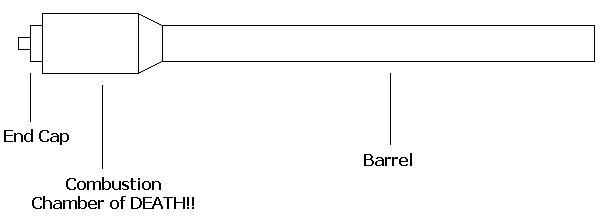By Mike Knippers and Dave Thaler
Table of Contents
Method
1. Commandeer a potato cannon.
2. Obtain a bag of potatoes and a bottle of hair spray.
3. Mass potato readied for launch
4. Prepare potatoes for launch by stuff them down the barrel until they
get above the combustion chamber.
5. Fill combustion chamber with fuel (hairspray) and cover with cap.
6. Point cannon straight up.
7. Prepare stopwatch to time.
8. Fire and start stopwatch.
9. Wait until potato hits the ground.
10. Stop stopwatch upon impact.
11. Record data.
12. Repeat steps for 20 data points.
13. Analyze

By use of these following physics formulas:
v = u + at
s = ut + (1/2)at²
Ke = (1/2)mv²
Pe = mgh
We started off by using v = u + at to determine velocity.
By cutting time in half, to get to the point at the top where u = 0, from
there we are able to calculate the final velocity using gravity and time.
8.36 seconds total round trip. Divide that in half to get 4.18 seconds.
Set u = 0
Set up equation
v = 0 + (9.8)(4.18)
v = 0 + 40.964
v = 40.964 meters / second
We then used Microsoft Excel to set up a spreadsheet to automatically calculate the velocity for each data point.
Now knowing the velocity, we will be able to calculate the height reached by the potato using s = ut + (1/2)at²
Once again, cutting the time in half to arrive at u = 0
s = (0)(4.18) + (1/2)(9.8)(4.18²)
s = 0 + 85.61475
s = 85.61475 meters
And then setting up a equation in our spreadsheet to calculate height for each data point.
Then using Ke = (1/2)mv² and Pe = mgh to determine energy present,
using each formula to check the other.
Ke = (1/2)(.12)(40.964²) = 100.68 Joules
Pe = (.12)(9.8)(85.61) = 100.68 Joules
To account for uncertainty we are including the factors of air friction and the ratio of air to hairspray in the combustion chamber.
Discussion
When we calculated the actual velocities of the potatoes, we were quite
shocked. We were estimating that they would fly around 15 meters/second,
but when calculated, it was more like 35-40 m/s. So was our hypothesis
conclusive? We think it is. We measured the distance from Daves house
to Tonys to be around 105 meters. And when we found the distance our potato
could fly, we ended up with 120 meters. We estimated that is would fly
at a high rate of speed, we just estimated way low. By use of our physics
knowledge, we were able to determine that it flew at a rate of speed unacceptable
on Americas freeway system, approximately 90 mph. However it would be
accepted on Germanys Autobahn. We also determined that potatoes flying
at that high of a velocity tend to make a louder THUD when hitting the
ground. Also increasing the crater size left behind. We are currently
thinking about researching the interaction between potato mass and velocity
on crater size.